Freedom Customers Take Their Princess 52 Flybridge and Axopar 28 to Alaska
9th July 2019
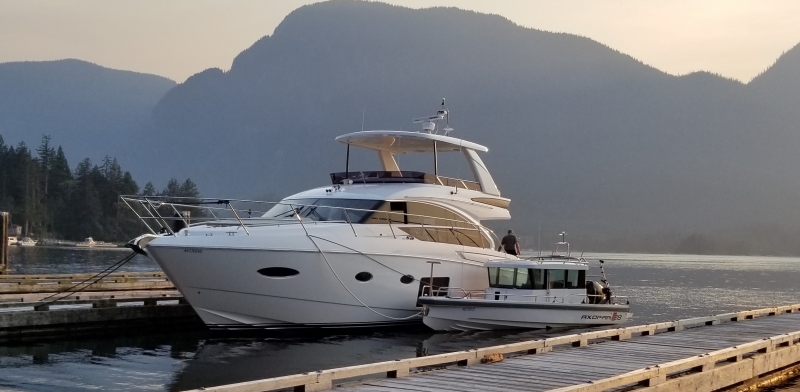
So you finally have your dream yacht, now your aspiration turns to where she might take you. The Gulf Islands? The San Juans? Princess Louisa Inlet? Maybe even Desolation Sound? Fine destinations all, but what about a true adventure? A journey. What would it be like to take your own yacht all the way to Alaska?
For most this seems like a far-fetched idea, crazy even, but then you talk to Princess 52 Flybridge owners Ken and Marlene Coffey – now veterans of two trips up the Inside Passage to Glacier Bay National Park – and you realize it’s really quite doable. Sure, it takes research, preparation and ideally, a minimum of six weeks. It also requires mad charting skills and in-depth knowledge of your vessel. But more than anything, says Ken, undertaking a voyage to Alaska requires an itch.
“For me, it was the idea of being in my own boat, maneuvering through an ice field,” he says of the idea’s origin. “That was my target. I’d never been to Alaska, but I knew the glaciers would be something to see.”
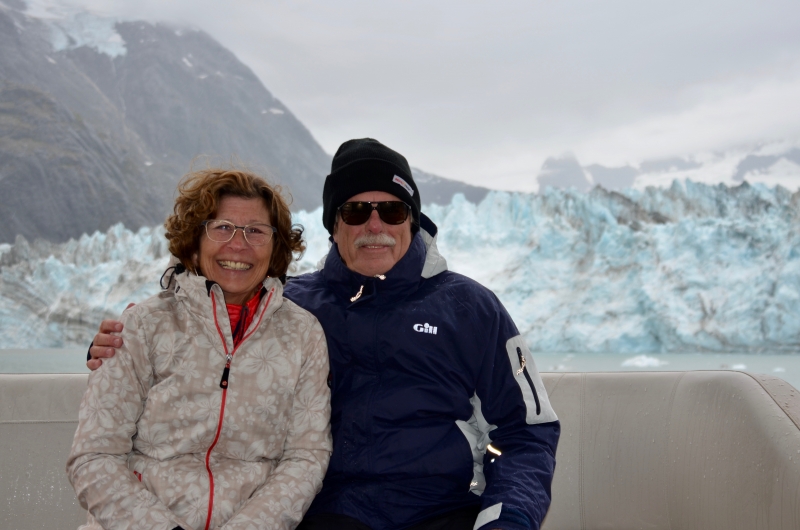
THE PERFECT MARRIAGE
Ken and Marlene have been boaters and married for a long time. That’s how Marlene knows ahead of time she prefers to stay behind in Calgary and run the couple’s business while Ken and his pal Gerry Kroon pilot the yacht on the trek north. Once the Princess is closer to Alaska, she and Gerry’s wife Ruth fly in to meet the yacht and continue on.
It’s a proven system, as Gerry and Ken work well together captaining on extended trips, enjoying the mechanics and technical details of this sort of travel where weather and tidal conditions are in constant flux, requiring a dance that’s equal parts physics and seat-of-the-pants intuition to know when to cover ground and when to duck into an inlet to wait for better conditions.
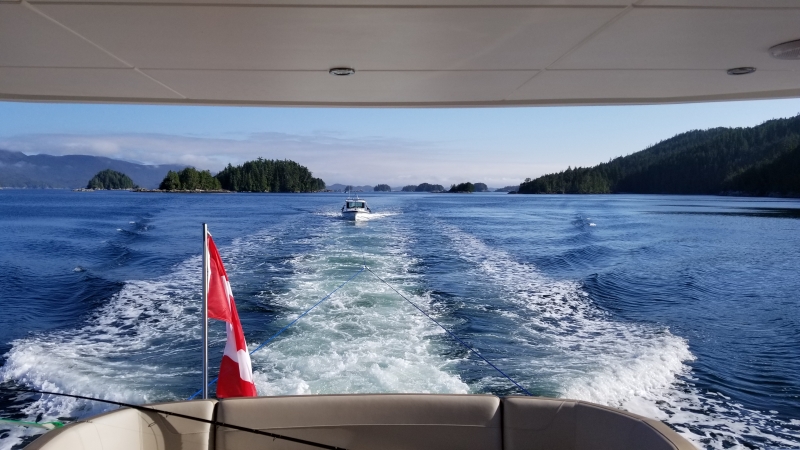
To make matters even more interesting, on their second voyage they decided to tow the Coffey’s 28 Axopar behind the Princess, another proposition that sounds daunting at first, but in actuality is fairly easy once a handling system is in place. The Axopar would provide the group with a smaller vessel to explore the countless arms and reaches along the northern coast and bring them in close to the calving glaciers. It would also come in handy for fishing excursions and wildlife safaris along the shoreline, saving fuel — and because the 28 is so quick — precious time.
The journey up to the Glacier Bay, a UNESCO World Heritage Site, can take up to two weeks depending on weather conditions and how much exploration you want to do along the way. “You can’t say you’re going to leave here at a certain time and get there at a certain time,” says Gerry. “You need to leave a good margin for weather and stay flexible.”
A CAUTIONARY TALE
Although Ken and Gerry say conditions all the way to Alaska are usually no sweat and very much like the sheltered conditions we’re used to here in B.C., there is one section of the journey that can rattle the most seasoned boater: Cape Caution, one of several “gates” along the Inside Passage where there is a break between the sheltering archipelago, exposing mariners to the open sea.
“We’ve learned to be very cautious when it comes to Cape Caution,” says Ken of crossing the widest expanse of open water en route to Glacier Bay, a notorious leg that can be extra tricky due to a large ocean-influenced inlet to the east that can add some “exciting” tidal conditions.
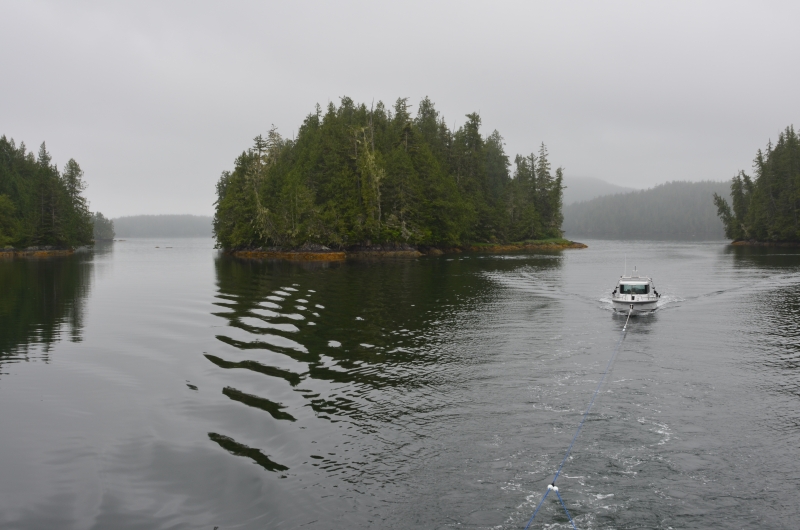
“You try for a slack tide because you’ve got the big inlet coming out into the ocean, but you can’t always time it with the wind and fluctuating weather,” says Gerry. “It can be surprising how rough the water can get,” adds Ken. “But you know when it’s too much… when it’s time to duck into an inlet and wait out the weather for a couple of hours or days.”
When asked what they do during these forced delays the guys trade a glance and laugh in unison, “Cocktails, of course!”
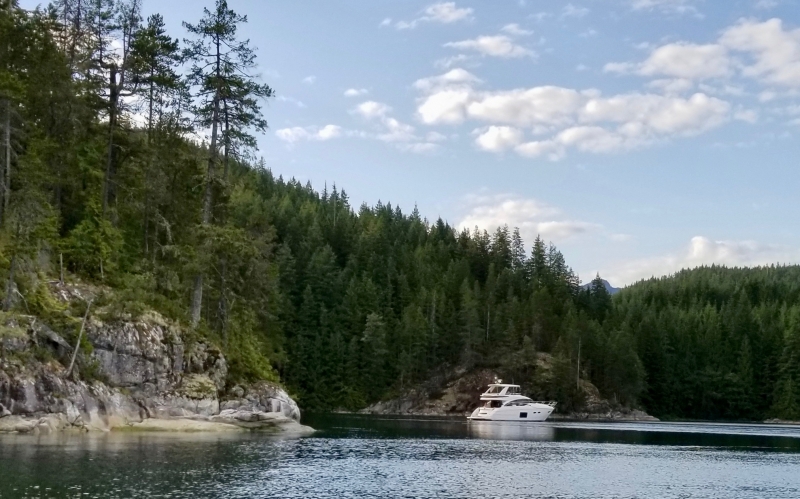
While Ken recommends that any Alaska-bound boaters study the few potentially dangerous sections ahead of time, there is really no need to be nervous because conditions are no worse than a rough day crossing the Georgia Strait. “Our boat could handle any of the conditions we were in, and even towing the Axopar was no problem. It’s more a matter of being physically comfortable and extra cautious.”
PARTY TIME
On their most recent trip, Marlene flew in to meet the yacht in the First Nation’s settlement, Bella Bella, on the central coast of B.C. “For me, the big adventure can be just trying to get to the boat,” she laughs. “You’re in a small plane, flying into a small village, there are no taxis, no signs, no one to give you directions.” She ended up catching a ride with a local to get to the marina.
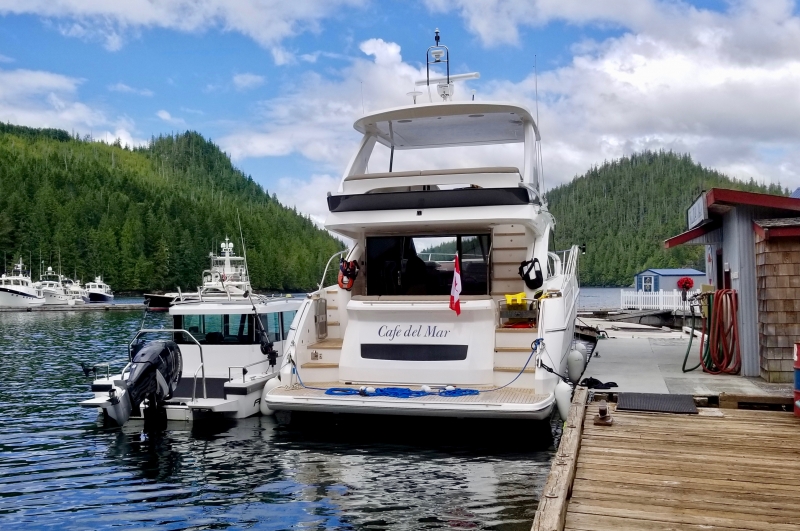
“One of my favorite parts of the trip is stopping in all the little settlements and meeting the local characters,” she says, describing one guy they met last summer, the self-described “bear killer” for the community, who wore a strand of huge grizzly claws around his neck.
She also enjoys how much people love the Princess. “It’s not like pulling into Coal Harbour,” she laughs. “It’s like we’re pulling in a superyacht. People are so curious and friendly.”
On this last voyage, the party was in full swing as soon as Marlene, Ruth and good friends Ken and Winnie arrived in Gustavus, the closest airport to Glacier Bay, where they’d spend a week exploring. Some evenings they caught their dinner on the Axopar and cooked it on the bridge of the Princess. Each night many glasses clinked while laughter flowed and whales and seals snuck up close, drawn by the curious sounds and smells of pure human delight.
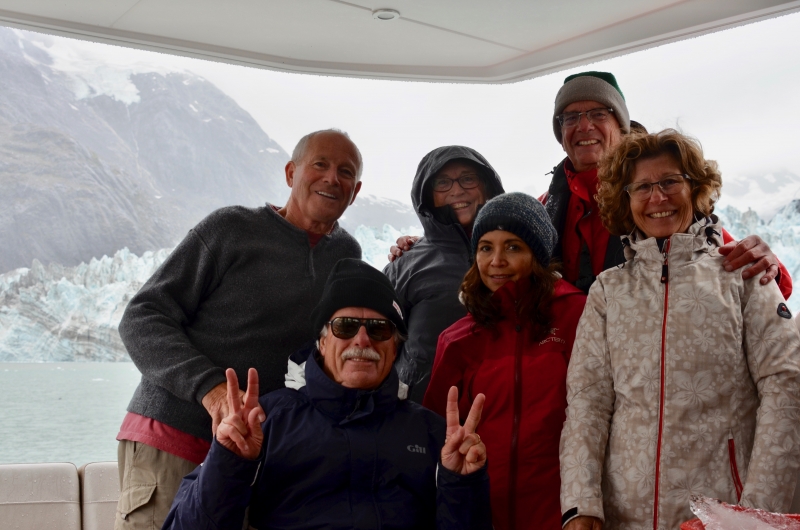 The players, from left: Ken Lineman, Ken Coffey, Ruth, Winnie, Gerry and Marlene.
The players, from left: Ken Lineman, Ken Coffey, Ruth, Winnie, Gerry and Marlene.
THE ULTIMATE DESTINATION
Glacier Bay National Park is a magical time capsule of undisturbed wilderness, homeland to the Tlinget band, as well as a multitude of land, marine and flighted tribes. As you approach the park all boat traffic is required to stop at Bartlett Cove, the last vestige of civilization, where you go through a National Park Service orientation establishing rules for speeds and wildlife distancing as well as recommendations for safe conduct around the ever-calving glaciers.
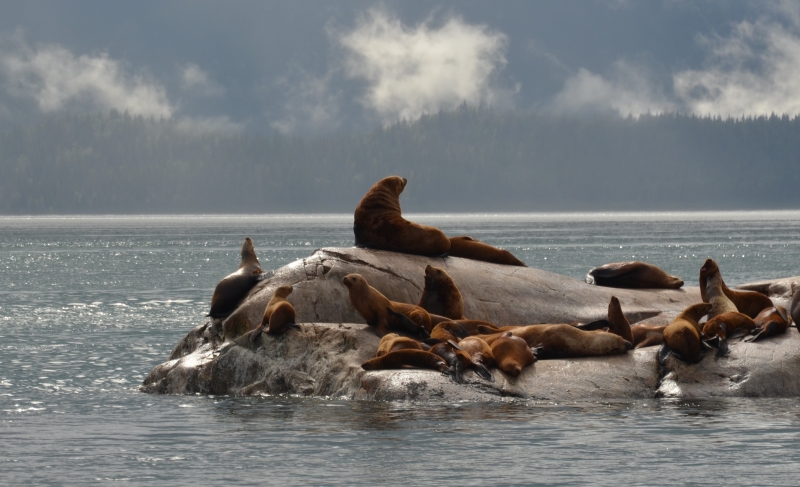
Boaters can only enter Glacier Bay with a permit, typically one you’ve applied for at least 60 days in advance. Between June 1 and August 31 regulations provide that no more than 25 private vessels may be permitted each day, with only 12 permits available for short notice entry.
Though it sounds like a lot of red tape, the Coffeys insist it’s a ridiculously small price to pay for the chance to be in the presence of such unspoiled beauty. The wildlife in the preserve is so prolific it’s as if you’ve been dropped into a David Attenborough documentary. “You’re in another community,” says Ken, “one made of wilderness and wildlife. And then…you see your first iceberg.”
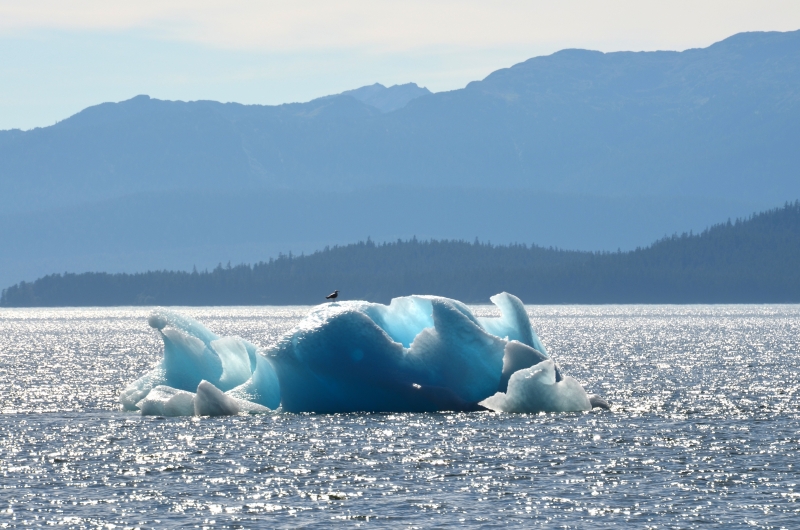
The pinnacle of the voyage is, of course, the otherworldliness of navigating around glacial icebergs until you find yourself at the foot of the giant glaciers themselves, towering walls of ice, prehistoric winter snow now slowly melting and joining the sea.
“Bam!” Ken bangs his hand on the 52’s sleek dining table for effect. “All of a sudden you’ll hear a big crack like a gunshot as the ice breaks and cascades into the water with a huge rumble.” He says the size of the ensuing waves is always surprising, remembering his first encounter, and how he went scrambling up to the helm just in time to turn the yacht’s bow into the surge.
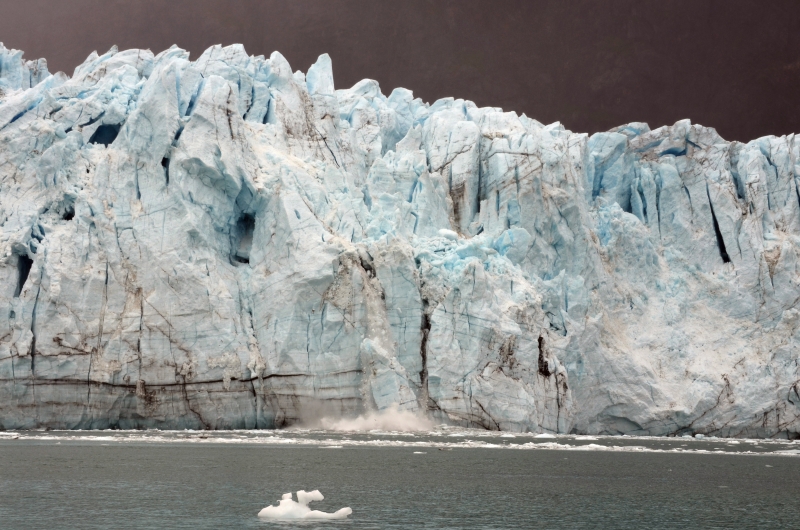
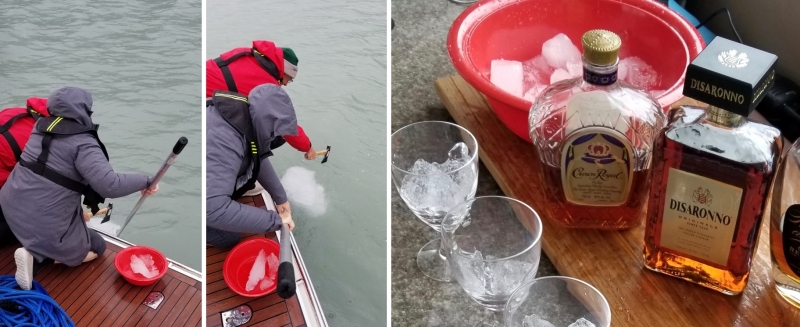 Nothing like freshly-caught glacial ice to chill your cocktails!
Nothing like freshly-caught glacial ice to chill your cocktails!
NEVER A BETTER BOAT
The Coffey’s say their Princess is the ultimate boat to have in Glacier Bay, or anywhere for that matter. Their last yacht, and the boat they took to Alaska the first time, was a Sea Ray 52 Sedan Bridge. Same length, “but this boat is much more comfortable and way more spacious,” says Marlene. “There is no comparison. Even with six adults living on the boat there was plenty of room. It never felt crowded.”
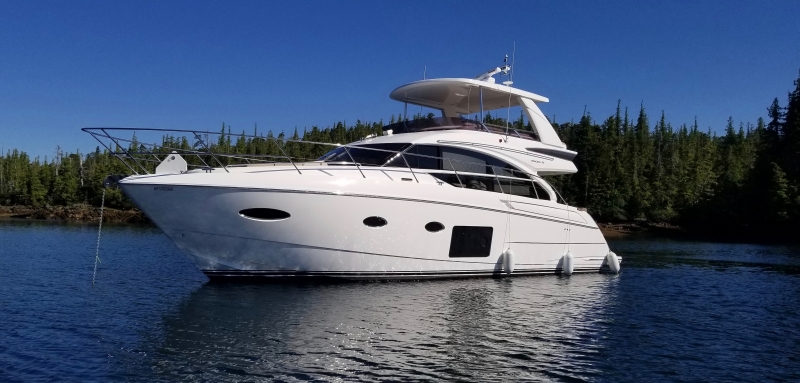
“And the 360 views from this boat are fantastic,” adds Ken. “There is such great visibility from the bridge, which you’d expect, but also from main deck with the huge picture windows. Even the staterooms below deck offer great views.”
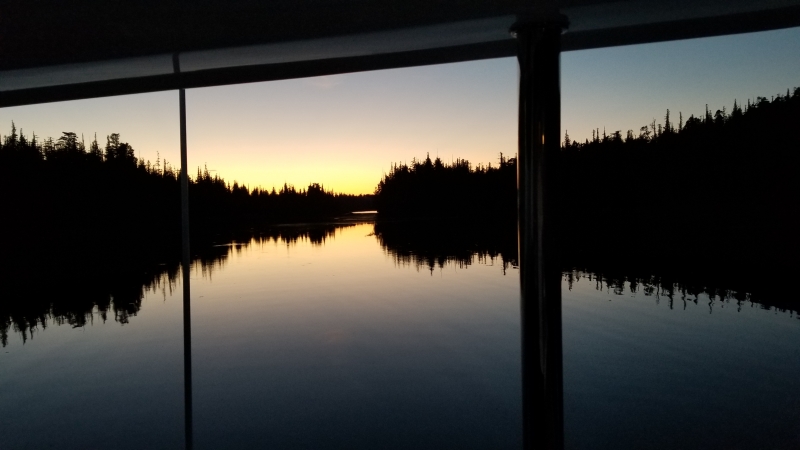
Add the 28 Axopar to the mix for a combination of luxury and efficiency that would be hard to match. The six friends would often leave the Princess anchored and explore to their heart’s content in the heated day boat. In one especially sketchy situation, the Axopar even served as a pilot boat when the group was maneuvering through a narrow passage that wasn’t well chartered. “We took the smaller boat ahead so we could gauge depth and accurately place all the rocks.”
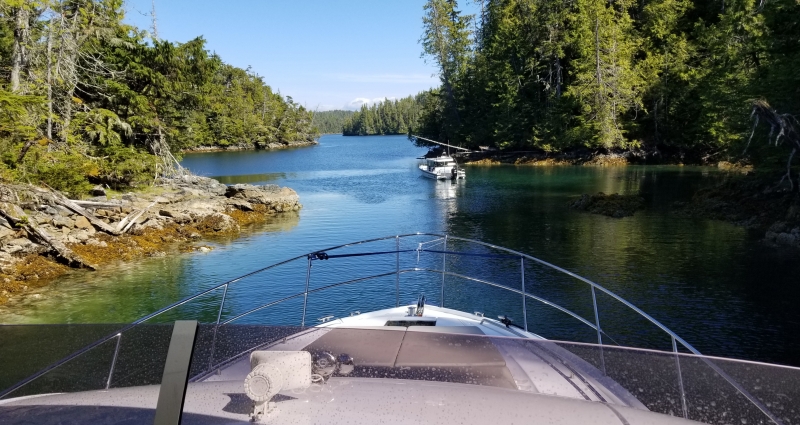
BEING WHALE WATCHED
Second only to experiencing the ice fields and the glaciers, Ken and Marlene say their whale sightings — especially the humpback encounters — have created their fondest memories. “It can happen anywhere along the way,” says Ken. “You’ll see a whale spout nearby, so you turn off the boat to watch them play.”
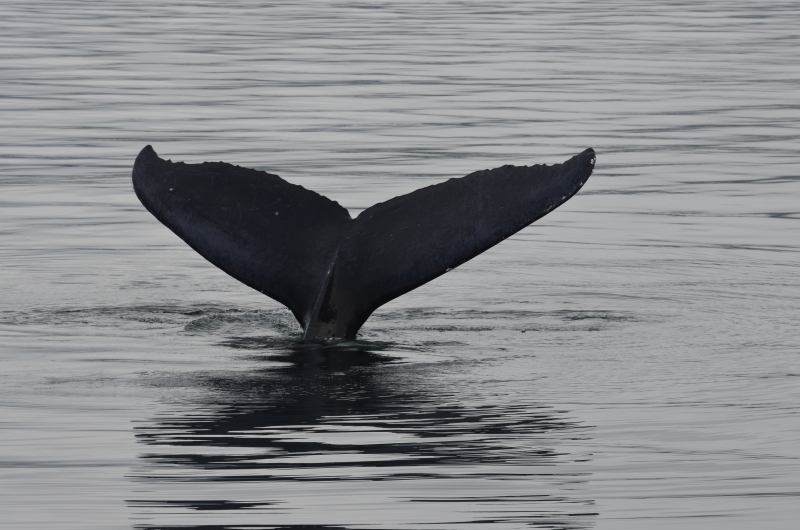
“One time we saw a whale not too far off and it seemed to be doing something different. It was just floating on the surface. When we were a couple hundred yards away we shut everything off to watch and the next thing we knew he was swimming along the sides of the boat, up and back and up and back, then under it and around it…coming in so close you could step off the boat and onto his back… just looking up at us and trying to figure it all out. It was incredible.”
Another time a group of Humpbacks surprised the group when it created something called a bubble net right off the back of the yacht. This unique hunting system involves a team of adult humpbacks using vocalizations to coordinate an attack. They will start swimming in circles around a school of small fish all the while blowing bubbles from their blowholes to create a “net” of sorts, which disorients and traps the fish. Then with a vocal queue from the lead whale the group will dive beneath and shoot upwards through the school en-mass, bursting out of the water with their giant mouths agape. “We didn’t know what they were doing at the time,” says Marlene, “eight to ten whales, each almost as big as our boat, just shooting up out of the water, right off the cockpit. It scared the sh*t out of us!” she laughs.
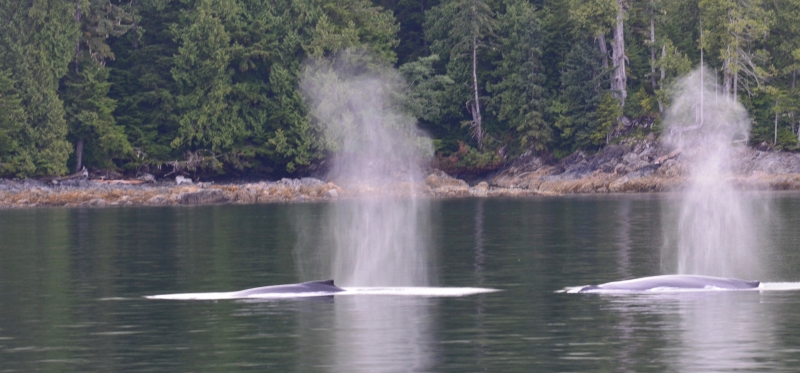
The Coffeys keep their Princess and Axopar in Coal Harbour and love the gleaming city scape that surrounds their slip. Whenever they’re in town drinks and storytelling out on the 52’s spacious cockpit are a nightly occurrence, and more often than not the conversation turns to adventure and the wide open, empty places they’ve come to love further north.
“Lots of people go from Vancouver to Desolation Sound and that’s the extent of their journey,” says Ken. “But it’s beyond Desolation where things get interesting. Where there’s space, and wild things. Solitude.”
“Just think of somewhere you really want to go and then plan for it,” he reminds us all. “For me, it was the daydream of navigating an ice field in my own boat…and that one target goal opened up a whole new world for us.”
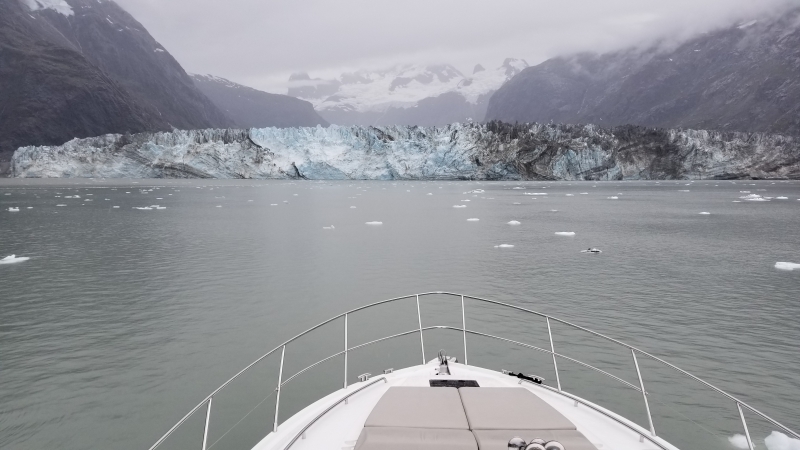
* * *
TRIP NOTES & TIPS
- A water maker is great to have. The first time we found water everywhere but it had been a dry winter before the second trip, so water was scarce at times. We invested in a portable machine that we could bring on deck as needed. It was literally a lifesaver.
- Bring spare everything: belts, filters, anything that can break. And tools, of course.
- Think what is the worst thing that could happen. For example, a heart attack. We recently added a portable defibrillator to our kit.
- You must have eyes on the water 100% of the time you are underway – and preferably two sets of eyes — no matter how long the day or how flat the water.
- Understand ahead of time where the potentially dangerous sections are and plan for every scenario.
- Make sure you have all the safety gear and that it’s high quality. Not necessarily the stuff that comes with the boat. And take that life ring out of the cupboard and have it on deck at all times.
- Get used to wearing your personal flotation device on deck. Invest in a high-quality vest that’s also comfortable to wear.
- Have a Spot or similar satellite messaging device, not only for emergencies but for checking in daily with people back home, letting them know your position for the night.
- If you have Isinglass your flybridge, ditch it for the trip as the increased visibility is well worth the extra clothes you might need up on the bridge.
- If you decide to tow a second boat, practice hooking and unhooking it in your home waters before you head out. It takes time to come up with a system that’s safe and convenient.
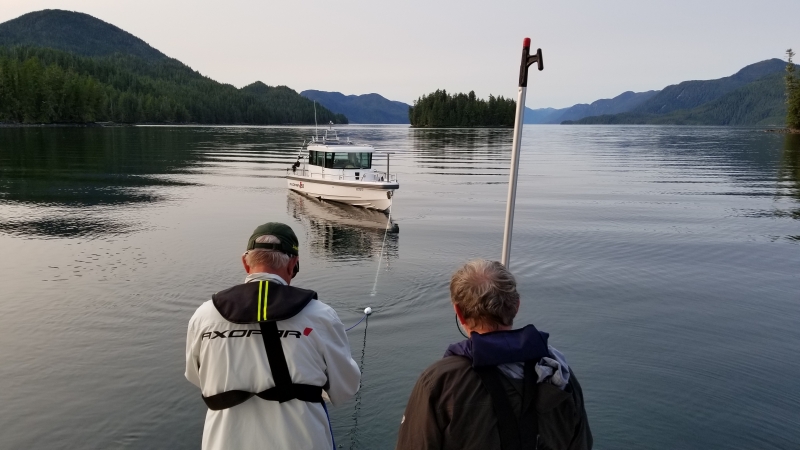
Ken and Gerry reel in the Axopar.
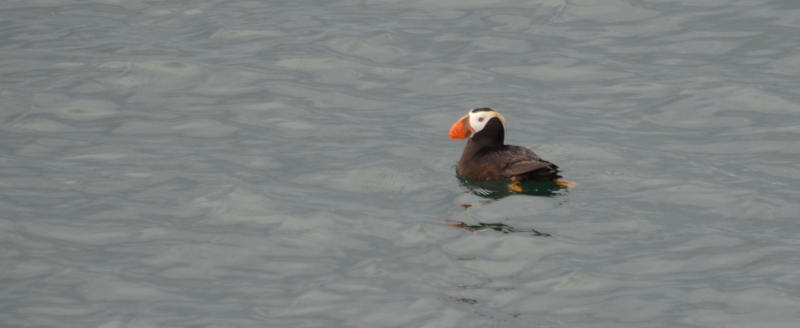
Puffin Sighting.
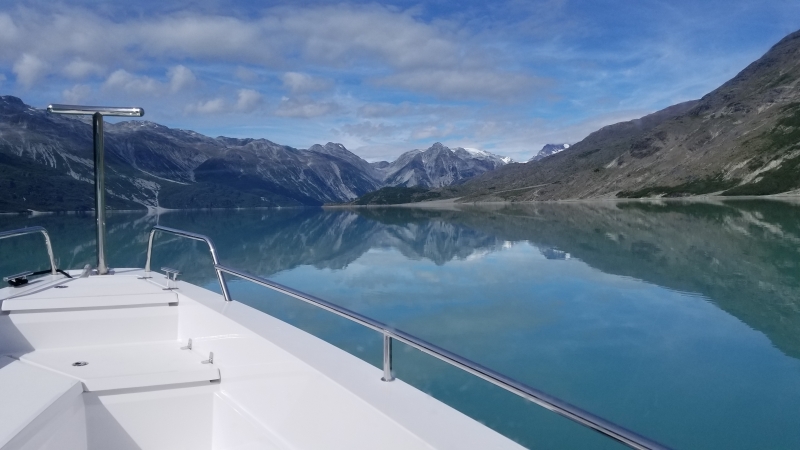
Because the Axopar is so quick and fuel efficient is was perfect for day trips and fishing.
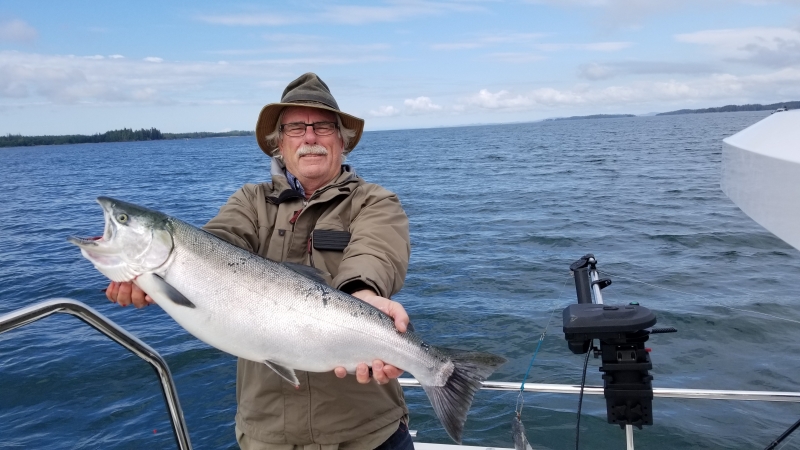
Dinner!
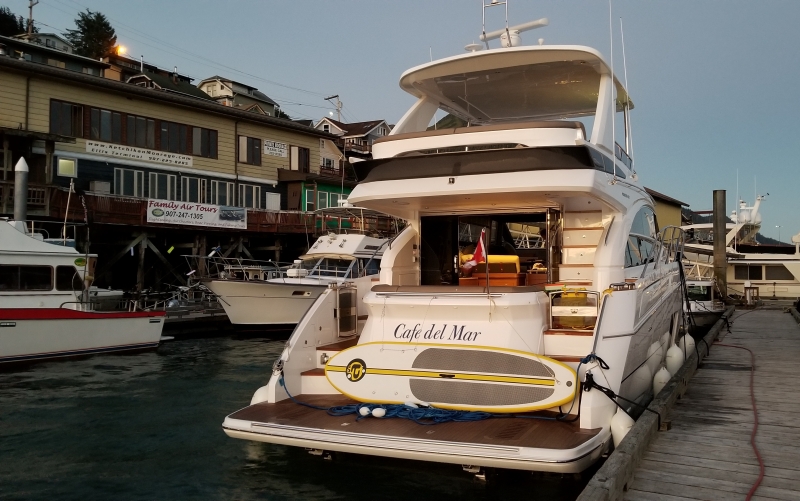
The crew loved getting off the boat in the little settlements where the locals were equal parts colorful and welcoming.
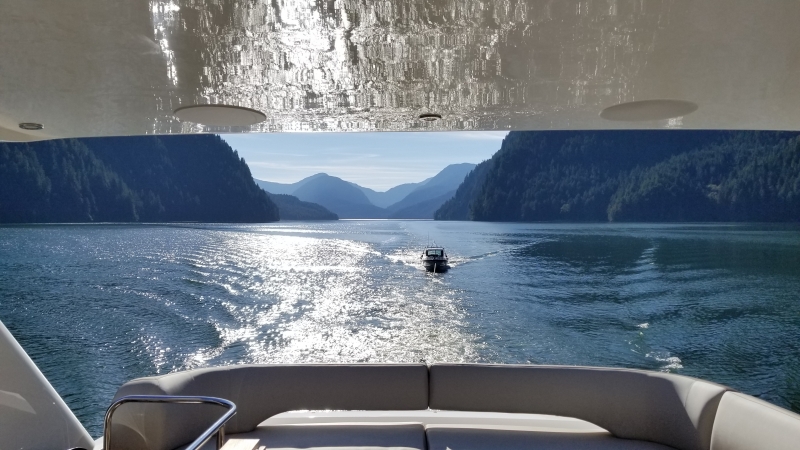
The Axopar only enhanced the stunning views.
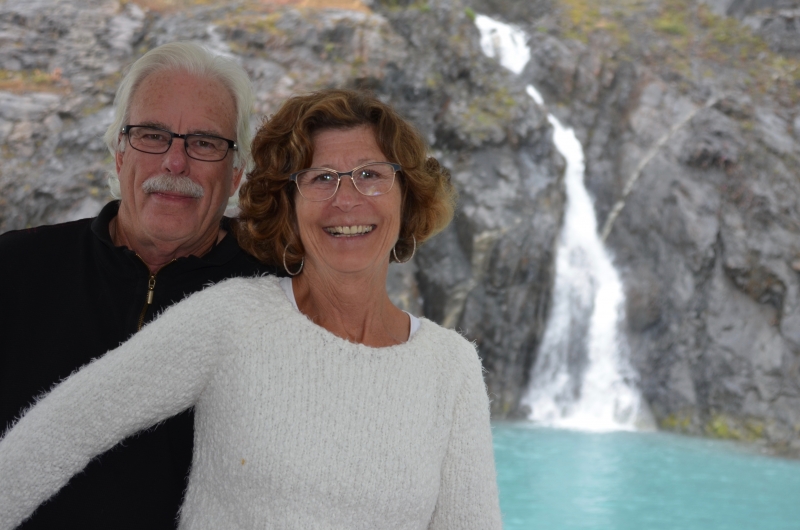
With two trips to Alaska behind them Ken and Marlene haven’t decided where their next big adventure will take them.
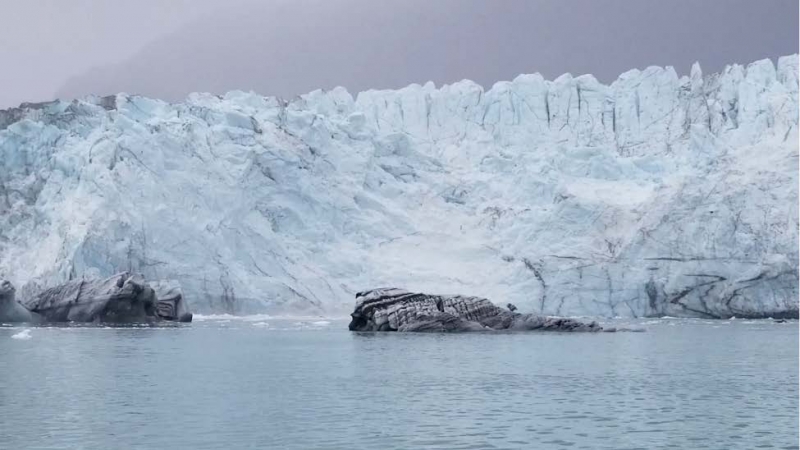
Imagine watching this scene from the deck of your own boat!


